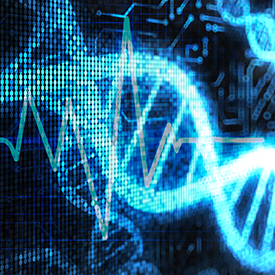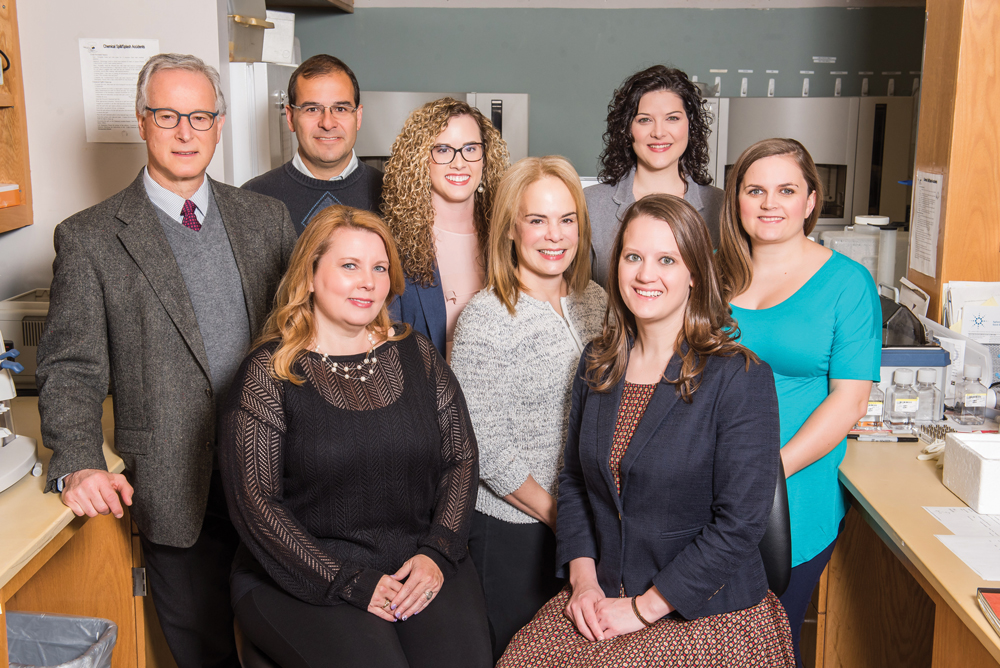 A group of UAB experts in genetics, infectious diseases, and other specialties are working to solve medical mysteries for patients from across the Southeast. It would be extremely unlikely that this sort of condition would be recognized in a setting outside a program such as ours,” says Bruce Korf, M.D., Ph.D., the Wayne H. and Sara Crews Finley Chair in Medical Genetics in the Department of Genetics and director of UAB’s Undiagnosed Diseases Program (UDP). He is referring to the case of a child born with profound developmental issues. The child is blind and deaf, suffers from multiple seizures, and has never smiled or sat up.
A group of UAB experts in genetics, infectious diseases, and other specialties are working to solve medical mysteries for patients from across the Southeast. It would be extremely unlikely that this sort of condition would be recognized in a setting outside a program such as ours,” says Bruce Korf, M.D., Ph.D., the Wayne H. and Sara Crews Finley Chair in Medical Genetics in the Department of Genetics and director of UAB’s Undiagnosed Diseases Program (UDP). He is referring to the case of a child born with profound developmental issues. The child is blind and deaf, suffers from multiple seizures, and has never smiled or sat up.
The results of whole genome sequencing revealed that the child has two gene mutations, one associated with seizures and developmental abnormalities and the other with impaired cognitive development. The genetic variants were categorized as de novo, or new mutations, meaning they occurred spontaneously. While there is no known cure for the child’s condition, the good news for the parents is the risk that such mutations would occur again if they have another child is very small. In addition, the risk to the family’s other children of one day having a child with these mutations and their associated conditions is no greater than in the general population.
Since it launched in 2013, the Undiagnosed Diseases Program has become a welcomed resource for patients suffering from medical mysteries that have defied diagnosis. “Undiagnosed diseases present a critical unmet need, with patients often cycling through the medical system for years with no satisfactory treatment plan,” says Korf.
Uncharted Territory
The National Institutes of Health’s Office of Rare Diseases Research says there are about 500 diseases common enough to be in any physician’s repertoire for diagnosis, while another 6,500 are known but extremely rare. For patients and their families trudging through the medical system with no answers and no plan, the UDP can be a ray of hope.
Primary team members are Korf; Maria Descartes, M.D., professor in the Department of Genetics; Martin Rodriguez, M.D., professor of medicine in the Division of Infectious Diseases; and Anna C. E. Hurst, M.D., assistant professor in the Department of Genetics. The team also includes certified genetic counselor Ashley Cannon, M.S., Ph.D., C.G.C.; genetic counseling assistant Ashley Haynes; and nurse practitioners Tammi Skelton, N.P.-C and Kaitlin Callaway, N.P.-C. The UDP can also draw on a range of UAB specialists according to patients’ needs.
 UAB’s Undiagnosed Diseases team includes (clockwise from left) Bruce Korf, Martin Rodriguez, Ashley Haynes, Ashley Cannon, Kaitlin Callaway, Anna Hurst, Maria Descartes, and Tammi Skelton.
UAB’s Undiagnosed Diseases team includes (clockwise from left) Bruce Korf, Martin Rodriguez, Ashley Haynes, Ashley Cannon, Kaitlin Callaway, Anna Hurst, Maria Descartes, and Tammi Skelton.
Since 2013, the program has seen more than 130 patients. Of the patients whose evaluations have been completed, more than half have received a diagnosis. Diagnoses are made through a combination of cutting-edge technology allied with more traditional medical strategies such as comprehensive review of records and history and extensive interviews with the patient and/or family. In many cases, the UDP partners with Huntsville’s HudsonAlpha Institute for Biotechnology to employ whole genome sequencing, which can identify genetic variants across any of the approximately 22,000 genes in the human genome.
“Now that we’ve had experience with genome sequencing, what we’re finding is several different kinds of outcomes,” says Korf. “Sometimes nothing is revealed that we believe is relevant to a person’s health problems. Then occasionally you make a diagnosis where you ask yourself, ‘Why didn’t I think of that before?’ It’s not an unknown, never-before-discovered diagnosis; it’s just a rare, unusual condition but well within the realm of what you theoretically could diagnose. But for whatever reason it doesn’t come to attention, usually because it’s presenting in a different way than you expect. Then sometimes you find things that you know in a million years you wouldn’t have thought of if it not for genome sequencing. You can pretty much guarantee it would have continued to go undiagnosed without the sequencing.”
This last scenario was the case with a patient whose condition, an inherited disorder classified as a lysosomal storage disease, had been described in the medical literature only once before. In another case, genome sequencing identified a genetic variant that was responsible both for a severe neuromuscular condition that impaired the ability of multiple members of a family to walk, as well as skeletal abnormalities. The gene was known to be responsible for either of these conditions, but it is usually not found to cause both in the same person. This discovery allowed the UDP to recognize additional problems for which family members were at risk and refer them to appropriate specialists for care.
Occasionally, the UDP team will find themselves exploring completely unmapped genetic territory. “We had an example recently of something that has never been described before,” Korf says. “Not only has the gene mutation not been seen before, but also the gene itself has never been shown to be involved in disease. But it’s looking like it may in this case. How do you prove that? That’s what we’re trying to do now, setting up research collaborations with colleagues across campus to try to figure it out.”
High-Tech Meets Time-Tested
Korf is quick to note that genome sequencing is only one tool the program employs, and in some cases it is not even the most critical element of their process. “Part of the success of the program is predicated not just on using sequencing technology; listening to the patient, thinking, and communicating with colleagues about a clinical problem have tremendous power also,” says Korf. “With the pressures of modern medicine, all too often that doesn’t happen. Sometimes you find that the diagnosis is there to be made if you listen really carefully.”
Examples of these non-genetic diagnoses include several patients who turned out to have previously unrecognized cancer that the UDP diagnosed in the process of their medical workups. “There are also a few patients who have what you might think of as routine diagnoses—lupus or other autoimmune diseases—that for whatever reason didn’t get diagnosed previously, usually because they were unusual presentations of what are otherwise well-described diseases,” Korf says.
As the program has expanded, so too has its mission. Korf sees therapeutics development as a natural extension of the UDP’s purpose. “It’s great when you can tell somebody after all this time, ‘This is what you have.’ Of course, the real triumph would be if you can do something about it and use that knowledge to develop a new treatment. That’s where I see us going: translating gene discoveries into searching for medications. It’s not just undiagnosed disease; it’s untreated disease. We’re not here just to put names on things; we’re trying to improve the quality of life for the people who are affected.”
By Bob Shepard and Jane Longshore